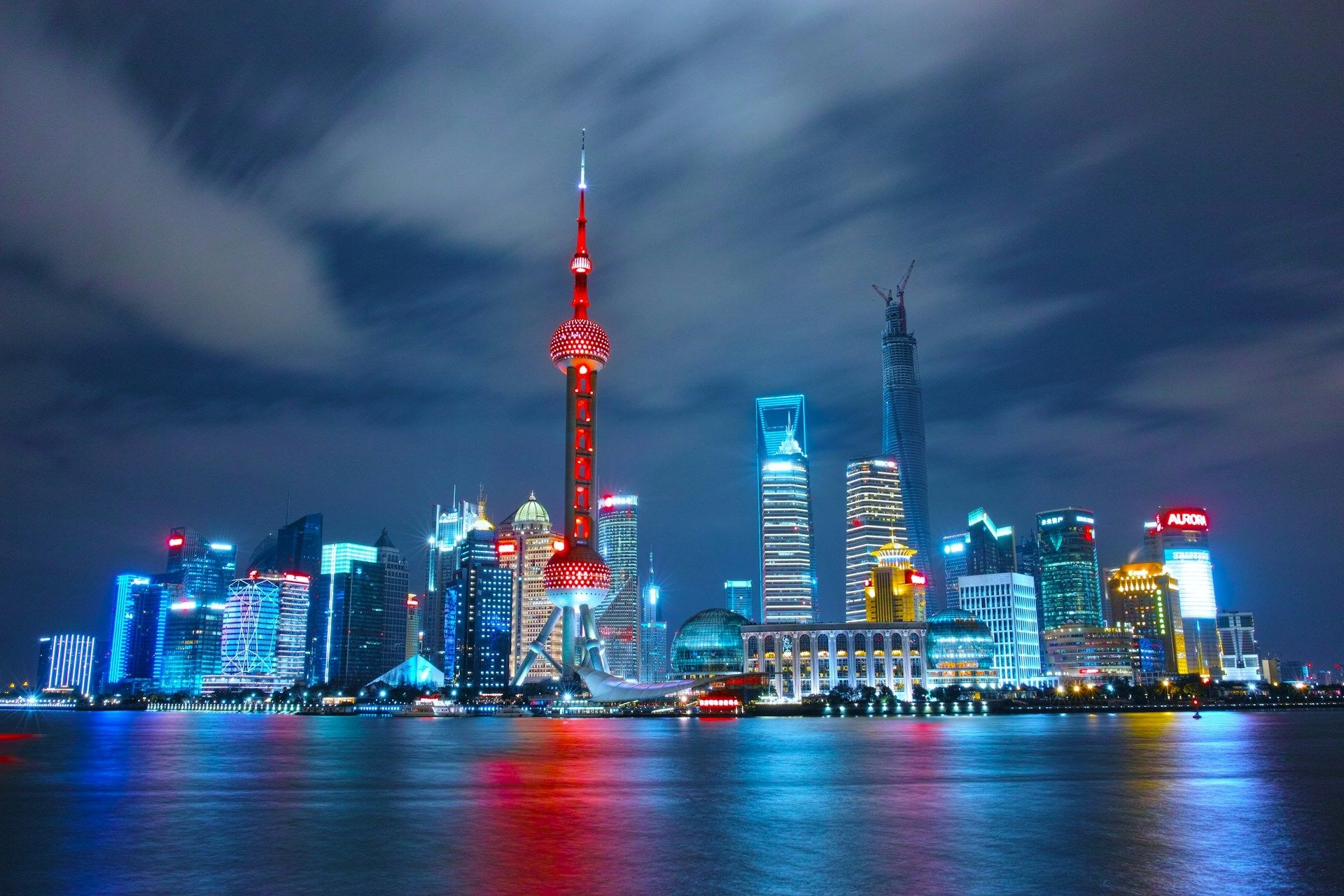Advantages of traveling
to China
Iconic Riverside Promenade & Skyline
Stroll the Bund at sunrise to admire colonial-era facades and Pudong’s futuristic towers lit in golden hues, offering photographers and romantics an unparalleled cityscape panorama.
Timeless Alleyways & Local Flavors
Wander the Former French Concession’s plane-lined lanes to sip tea in centuries-old teahouses, discover hidden art galleries, and sample xiaolongbao at family-run dumpling shops rich in local heritage.
Modern Marvels & Cultural Fusion
Ascend Shanghai Tower for 360° views, explore the curated exhibits of the Power Station of Art, and dance the night away in neon-lit districts—blending history, innovation, and nightlife.
Iconic Riverside Promenade & Skyline
Stroll the Bund at sunrise to admire colonial-era facades and Pudong’s futuristic towers lit in golden hues, offering photographers and romantics an unparalleled cityscape panorama.
Timeless Alleyways & Local Flavors
Wander the Former French Concession’s plane-lined lanes to sip tea in centuries-old teahouses, discover hidden art galleries, and sample xiaolongbao at family-run dumpling shops rich in local heritage.
Modern Marvels & Cultural Fusion
Ascend Shanghai Tower for 360° views, explore the curated exhibits of the Power Station of Art, and dance the night away in neon-lit districts—blending history, innovation, and nightlife.

Useful articles
and recommendations from experts
Global Transactions
All
Popular
China
Pay for Property in China from Abroad — USD/CNY Bank Transfer
Clear totals, basic documents and calm timing
26.08.2025

All
Popular
Global Transactions
China
Transfer Funds to China — USD/EUR to CNY (RMB), Simple Guide
Clear options, all-in cost visibility and predictable timing
26.08.2025

Tourism in Shanghai: Flights, Accommodation & Best Activities
Introduction: Shanghai’s Dynamic Duality
Shanghai, China’s largest metropolis, sits at the mouth of the Yangtze River, engaging travelers with its seamless blend of historic charm and cutting-edge modernity. As the nation’s financial powerhouse and cultural beacon, Shanghai offers colonial promenades, Art Deco landmarks, and sky-piercing towers alongside traditional shikumen alleys and centuries-old temples. Whether you’re drawn by world-class shopping, global-style cuisine, or immersive art and history experiences, Shanghai provides a multifaceted urban adventure that caters to families, solo travelers, and business visitors alike.
Getting There: Airports & Transport Connections
Shanghai is served by two major international airports:
- Pudong International Airport (PVG): Handles most intercontinental flights, with direct services from New York, London, Paris, Tokyo, Sydney, and over 100 other cities. High-speed Maglev service connects PVG to Longyang Road Station in just 8 minutes, where you can transfer to the metro network.
- Hongqiao International Airport (SHA): Primarily domestic and regional flights from Beijing, Hong Kong, Seoul, and Osaka. Direct rail links and metro lines (Line 2) bring passengers to the city center in under 30 minutes.
Where to Stay: Accommodation by District
Shanghai’s lodging reflects its diverse neighborhoods:
- The Bund & People’s Square: Luxury hotels like The Peninsula and Fairmont Peace offer river views and easy access to historic landmarks and high-end malls.
- Pudong Lujiazui: Home to Shanghai Tower, IFC, and international brands; sleek skyscraper hotels provide sky-lobby cocktails and direct access to the Financial District.
- French Concession & Xuhui: Boutique guesthouses and heritage inns in tree-lined lanes place guests near stylish cafés, art galleries, and Xintiandi’s nightlife.
- Jing’an & Changning: Mid-range business hotels and serviced apartments suit conference attendees and families seeking quieter streets and local markets.
- Hongkou & Yangpu: Budget hostels and youth-hostel chains offer affordable stays near Tongji University, creative hubs, and riverside parks.
Iconic Attractions & Must-See Sights
1. The Bund & Riverside Walk
Stroll along the 1.5-kilometer Huangpu River promenade to witness Shanghai’s architectural timeline: from 1920s Art Deco gems like the Peace Hotel to the neon-lit spires of Pudong’s skyline. Early mornings offer tranquility and golden light, while evening illuminations transform the waterfront into a dazzling spectacle. Boat cruises provide alternative perspectives of both the historic Puxi and modern Pudong facades.
2. Pudong Skyscrapers & Observation Decks
Pudong’s Lujiazui district showcases global firsts:
- Shanghai Tower: China’s tallest building and the world’s second-tallest. The observation deck on the 118th floor features 360° panoramic views and an interactive skywalk.
- Jin Mao Tower: Its tiered pagoda design houses the Grand Hyatt with floor-to-ceiling vistas from its 88th-floor bar.
- Oriental Pearl TV Tower: Iconic spheres host a revolving restaurant and a glass-floored observation pod at 263 meters.
3. Historic Shikumen Alleys & Temples
Discover Shanghai’s traditional soul in preserved quarters:
- Shanghai Old Street: Stone-paved lanes lined with Qing-era architecture, hosting tea houses, snack stalls, and handicraft shops.
- Yuyuan Garden & Bazaar: Ming-style pavilions, winding corridors, and koi ponds form a classical retreat; the surrounding bazaar offers jade, silk, and hand-painted porcelain.
- Longhua Temple: Shanghai’s oldest Buddhist temple, featuring ceremonial halls, pagodas, and morning chanting rituals that welcome visitors.
4. Cultural Districts & Museums
- Power Station of Art: China’s first state-run contemporary art museum housed in a converted power plant—hosting rotating exhibitions by leading Asian and global artists.
- Shanghai Museum: On People’s Square, its rounded “bronze vessel” building contains jade, ceramic, calligraphy, and ancient coin collections—entry is free, though advanced booking is recommended.
- Propaganda Poster Art Centre: A hidden gem in a French Concession basement, showcasing revolutionary-era posters that trace China’s visual propaganda history.
- M50 Art District: Converted factory spaces in Putuo district host independent galleries, design studios, and street-art murals—ideal for contemporary-art aficionados.
Food & Culinary Adventures
Shanghai cuisine fuses Jiangnan sweetness with global influences:
- Xiaolongbao (Soup Dumplings): Bite-sized parcels filled with pork broth—best sampled at Din Tai Fung, Jia Jia Tang Bao, or neighborhood shops in Huanghe Road Food Street.
- Shengjianbao (Pan-fried Buns): Crisp-bottomed buns stuffed with broth and pork, acclaimed at Yang’s Fry-Dumpling stalls.
- Local Snacks: Erkuai rice cakes, glutinous rice balls (tangyuan), and smoked sashimi at Chenghuang Temple Market.
- International Dining: Michelin-starred restaurants in Jing’an and Xintiandi, plus fusion bars in the Tianzifang creative enclave.
- Tea Culture: Private tea ceremonies in Hongqiao teahouses—learning leaf-selection, brewing methods, and Gongfu tea etiquette.
Shop & Explore: Markets to Malls
- Nanjing Road & Huaihai Road: Pedestrianized ribbons of global luxury brands, department stores like Shanghai No.1 Stores, and local boutiques in former-French-Concession arcades.
- Tianzifang & Xintiandi: Restored lane houses housing craft shops, art studios, cafés, and bars—perfect for leisurely browsing.
- AP Plaza (Science & Technology Museum Station): Underground market for electronics, souvenirs, and fabric outlets—bargaining expected.
- Global Harbor & IFC Mall: Mega-malls on both Puxi and Pudong sides offering immersive entertainment, dining, and indoor amusement parks.
Day Trips & Nearby Escapes
- Zhujiajiao Water Town (50 km): Ancient canals, covered corridors, and stone bridges; tasting local rice wine and mooncakes.
- Hangzhou & West Lake (180 km): Bullet trains reach Hangzhou in 45 minutes—cycle around UNESCO-listed West Lake and sample Longjing tea at lakeside plantations.
- Wuzhen & Xitang: Other water towns reachable by bus; known for architecture, local crafts, and night-time lantern festivals.
- Mount Huangshan (300 km): Scenic hikes through granite peaks and sea-of-clouds vistas—best combined with Hefei or Hangzhou fly/train segments.
Practical Tips & Seasonality
- Spring (March–May): Mild temperatures and blooming magnolias—ideal for garden visits and river cruises.
- Summer (June–August): Hot, humid weather with occasional typhoons—focus on early-morning outdoor activities and evening indoor concerts.
- Autumn (September–November): Crisp air, clear skies, and fall foliage in parks—peak season for photography and food festivals.
- Winter (December–February): Cool, damp conditions—visit indoor museums, hot springs in nearby Jiangsu, and Lunar New Year markets.
- Packing Essentials: Layers for variable weather, sturdy walking shoes for cobblestone alleys, portable umbrella, and a power-bank supporting USB-C and China plug adapters.
Why Shanghai Beckons Return Visits
Shanghai’s continual reinvention—from historic shikumen restoration to burgeoning art districts and next-gen skyscraper developments—ensures fresh discoveries on each journey. Its convergence of global finance, creative industries, and living traditions fosters events like Shanghai Fashion Week, International Film Festival, and world-class exhibitions at the National Exhibition and Convention Center. As a crossroads of East and West, past and future, Shanghai’s magnetic energy, culinary innovation, and cultural depth invite travelers to return again and again.
Final Note
We provide expert insights and up-to-date recommendations on flights, accommodations, and activities—so you have all the information you need to plan and enjoy your Shanghai adventure to the fullest.

